10 years of Android: remember everything
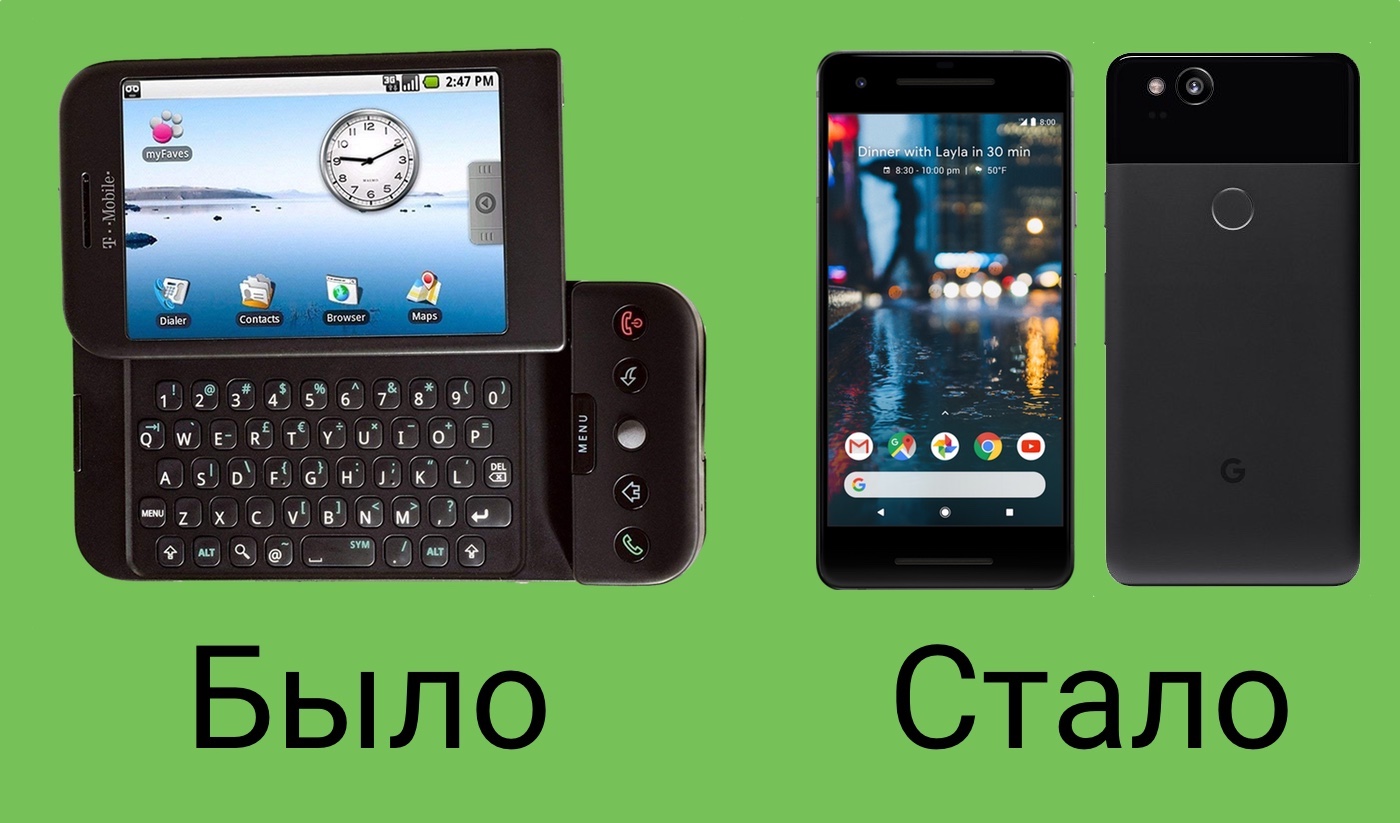
Ten years ago, 23 September 2008, the release of Android 1.0 , and was presented the very first androidfon the HTC Dream . Now Android is the OS with the largest user base in the world, and then it all looked like a project that could easily fail.
On the occasion of the anniversary, we decided to remember how the system has changed throughout this time. Since we are holding a Mobius conference , Android is interesting to us not only as users, but also in terms of application development. So we remembered important moments for developers, Vladimir dzigoro Ivanov helped us in this - a member of the Mobius program committee, who has been writing for Android since 2009.
Prehistoric times
To better understand the development of Android, it is worth remembering what preceded the release.
In 2003, when almost all mobile phones were simple “dialers,” a start-up Android Inc. appeared in California. The new company barely had enough money to rent an office, but co-founder Andy Rubin had valuable experience. His previous company is Danger Inc. made a Danger Hiptop device, which was then described with the words "a combination of a phone, a PDA and a pager":
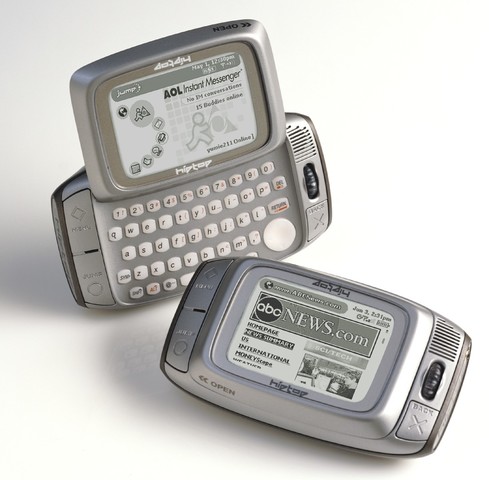
Initially in Android Inc. intended to make a platform for digital cameras, but in 2004 turned toward the phones. And in 2005, Google bought the company, and Android turned from an unobtrusive startup into an Internet giant project.
However, this did not guarantee success. “Smart phones” were becoming more popular, but the OS market seemed already divided for them: Windows Mobile, Symbian, BlackBerry OS and Palm OS settled there. How to deal with them a new platform, even if it is from Google? The calculation was that the phone manufacturers are unhappy with the need to pay Microsoft for using Windows Mobile, so the free OS has an advantage.
Both the smartphones themselves and the scenarios for their use were very different then from our days. When there is no front camera or GPS, and the Internet is at 2G speeds, this is clearly not for selfie, navigation, and online video — this is for email. But the main difference is that the screen was either designed to be entered by the stylus, or was not touch-sensitive at all, and the main input method remained physical buttons. And Google initially came from the same. When in 2006, the company showed developments for mobile operators, they looked like BlackBerry: a lot of buttons, a small horizontal screen, the word “touch” never appears.
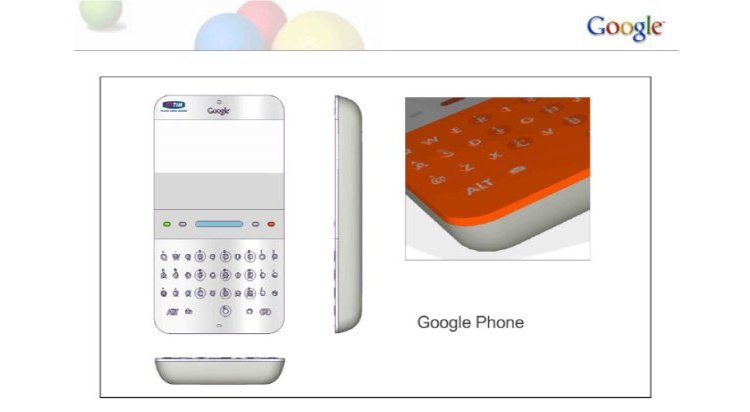
And in 2007, the iPhone was introduced. And it was not just the appearance of another competitor, but a new approach based on touching the screen without any stylus. Looking at the novelty, Google partially revised their views. It was decided that touch screens are needed, but they did not hurry to abandon the physical buttons. And next year they presented the result to the world.
2008
So, ten years ago the first androidphone was introduced under the control of the first release version of Android. The device had three names (T-Mobile G1 in the USA, Era G1 in Poland, HTC Dream in the rest of the world). But Android 1.0 had no name: the tradition of “desserts in alphabetical order” arose later. There were more version names for robots, but only for Pre-Rez versions .
Like the Danger Hiptop six years earlier, the HTC Dream screen shifted, giving access to a physical keyboard. And at that time, it was the only way to enter text: there was simply no on-screen keyboard in Android 1.0.

Was not on the screen and the usual series of three buttons. Firstly, they were also physical, and secondly, their dialing was somewhat different: the buttons for starting and ending a call, “Home”, “Back”, “Menu” - and a clickable trackball. In general, if desired, this device could be used without touching the screen at all. Moreover, the multitouch was not supported, and there was no “two-finger approach”. By the way, the screen itself was with a diagonal of 3.2 ": now it would be considered tiny, and then it was large, the screens have grown to a modern size very gradually.
And from the point of view of mobile development, this is interesting. As you know, before the release of the first iPhone, Steve Jobs believed that he didn’t need any third-party applications - they’re saying that you can open any site in the browser. And as a result, the App Store, without which it is difficult to imagine iPhones, appeared only a year later. So, Google acted differently: Android Market (predecessor of Google Play) was announced before the release of Android 1.0, and became available to users on October 22, 2008. At first, he could not boast a wide range, but, in general, there is also an anniversary here!
2009
The first release was based on the “release what we have” principle: it was obvious to everyone that there was still much to be added, but for such a large-scale project this is expected. It is not surprising that throughout the next year the system was supplemented with capabilities that we now take for granted. Among the features of version 1.5 (April 2009) - auto-rotate the screen, shooting video, widgets. And finally, the on-screen keyboard. And at the same time, those same dessert names: 1.5, which became the third release version, was named Cupcake.
In the autumn with the release of version 2.0, this was supplemented, for example, by supporting flash when taking a photo. And in the same autumn another notable event occurred: the output of the Motorola Droid smartphone. In the first months after the release of Android, it was not obvious whether it would turn out to be massively in demand at all, and Droid sales in the USA for the first week are estimated at 250,000 units, which then was a very impressive result. And it was an important achievement not only for a specific device, but also for the entire platform, proving its viability.

Probably, in part, we can thank for this operator Verizon. Since at that moment the iPhone in the US was exclusive to AT & T, other operators wanted to answer with something - and Verizon accompanied the launch of the Droid with an aggressive advertising campaign, highlighting its advantages over the iPhone (curiously, the first one was still called the physical keyboard):
Vladimir Ivanov : In these troubled times, Ant or IDEA was used to build the project (although the ascetics used the DDMS plugin for Eclipse). From the tools of asynchronous work were AsyncTasks and bare threads in services.
2010
In January, the Nexus One appeared - the first of the Nexus phones, on which Google worked directly with various manufacturers. He no longer had a physical keyboard, so Google rejected the idea. And in June, the first Samsung Galaxy S went on sale - and this is how the most popular series of Android flagships appeared, where tens of millions of copies go to every generation.

Meanwhile, Android continued to actively add what users craved. In 2.2 Froyo (May 2010), Adobe Flash support appeared! Many were overjoyed! True, after a year and a half, Adobe curtailed this support, the Internet gradually moved to HTML5, and the word “flash” became abusive, but that’s another story.
In addition, users were able to transfer installed applications to a microSD card. Now the significance of this may not be obvious, so we will explain: in the phone itself, storage could then be, for example, a measly 256 megabytes. But the card in it could be thrust from the heart, gigabytes at 16. And when applications could be installed only on the device itself, without transferring to the card, a difficult choice “if you want to install something, constantly removed, to free up space” .
But against the background of these improvements, the eternal damnations of Android first manifested themselves: fragmentation and updating of versions on devices that have already been released. For example, at the same Motorola Droid, the manufacturer promised a quick update to 2.2, and kept its word - but in the USA. And in Europe it was terribly demanding, causing a storm of curses "Why can Americans transfer applications to the map, and we are not on the same devices?". But the funniest thing turned out to be in Russia: in the autumn of 2010, Motorola announced it was leaving the country, and the promised update did not appear at all.
Without rushing to update Android, manufacturers vigorously wrote branded wrappers on top of the OS to differ from each other. Geeks spat (“the phone only slows down because of this”), but the only noticeable alternative with Android stock was the Nexus series.
In addition, in 2010, the endless litigation of Oracle v. Google began. While Java was a product of Sun Microsystems, there were no complaints about using Java on Android, but in 2009, Sun was absorbed by Oracle - and the new owner saw in the acquired opportunity to sue billions.
2011
A year earlier, the iPad appeared, and the tablets seemed like a brave new world comparable in scale to smartphones. Samsung responded to the first Galaxy Tab back in 2010, but was forced to use the “phone” Android, which was not optimized for the 7-inch screen. It was obvious that Google needed support here, and it followed in the form of Android 3.0 Honeycomb.
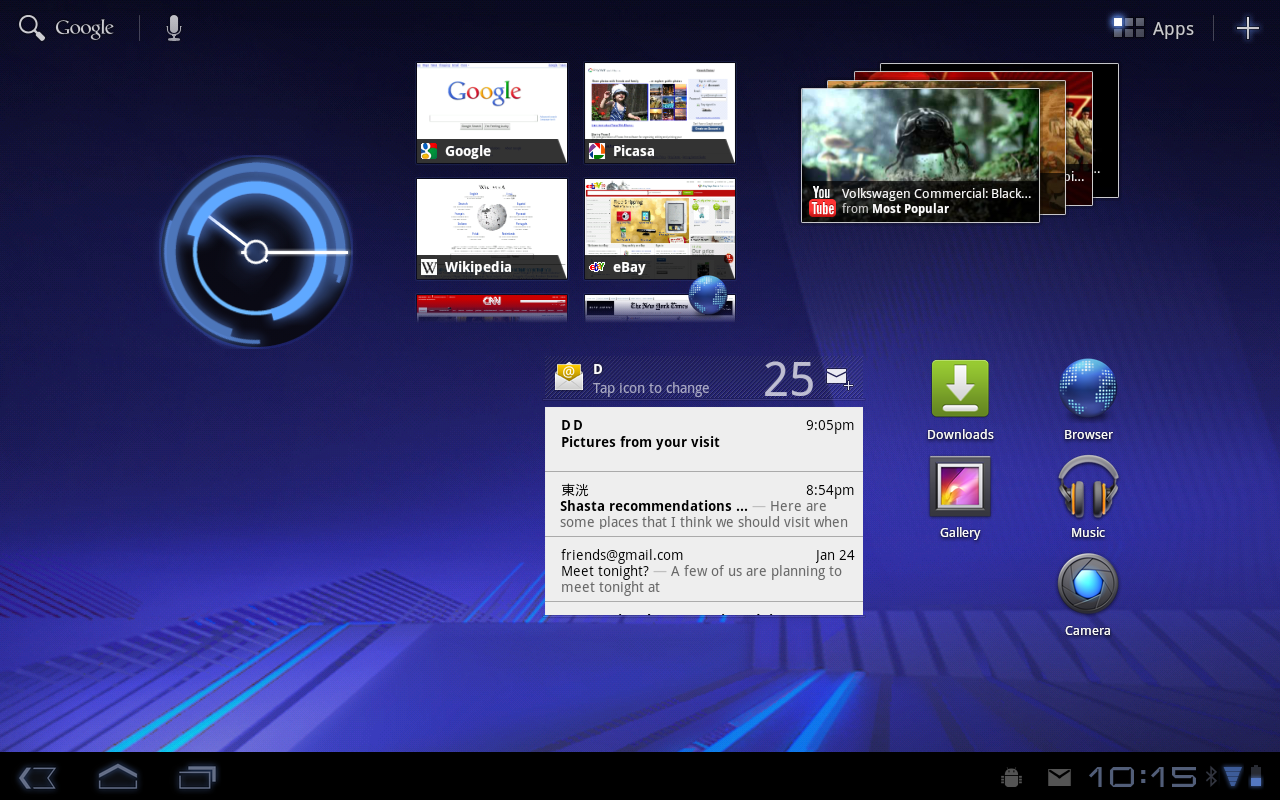
For large screens, other interfaces were clearly needed — for example, simultaneously showing an open letter and a list of letters, and not just one of these. And in Android-development, there appeared “fragments” (fragments) designed for this: so that individual elements can be demonstrated depending on the situation, at least together, at least one by one.
Release the first loud device and then wanted to Motorola with a tablet Xoom. Once again, a video was made with jokes about Apple, this time a high-budget hint at Apple ’s classic “1984” advertising :
However, this time it did not work: Xoom failed on sale, and Android 3.x versions turned out to be the most unclaimed. Later things went better with tablets, but they never reached the level of smartphones. Among Android developers, fragments began to be considered one of the most controversial things. Rather than a very successful company, Motorola bought Google for patents, later reselling everything else to Lenovo.
Well, but on smartphones everything was fine: there Android in 2011 became the most popular OS. He was no longer catching up, and he no longer needed to prove his superiority with physical buttons. Actually, the buttons themselves are gone: in the same year, the screen appeared in Android.
Vladimir Ivanov : Loaders and support library came with fragments. Now improvements in the platform could be dragged inside your application. The assembly was done by hand — some through Maven, some shell scripts, some, God forgive me, via CMake.
2012
Finally, there was no longer a need to “urgently release the features that are needed yesterday,” and now they were digging into the depths of quieter, improving already done. In Android 4.1 Jelly Bean, Project Butter became the main thing: “oil” in the title means that all animations in the interfaces should occur like clockwork at 60 fps, and not twitch.
The situation with the smartphones was approximately the same: there were no more fundamental changes there, but the performance continued to grow, and in 2012 the Nexus 4 had 2 gigabytes of RAM and a 4-core processor. Now it was possible to do everything the same as before, but faster and more convenient.
By the way, about "do all the same." If in the first years of the existence of Android, there were not many applications to which we are accustomed now (from Uber to Viber), then by 2012, the current list of leaders had more or less formed. Perhaps, the last giant bastion was Instagram: it was known on iOS since 2010, but they didn’t rush to release the Android version, although with the increased popularity of the platform it already looked weird. Recall that then Instagram itself was different from today: there was no direct, no story, no web version, no video. Only photos, and only square.

On April 3, 2012, the bastion finally collapsed, and Instagram appeared on Google Play. By the way, just before that, the very name “Google Play” appeared. Initially, the application store was called the Android Market, but by 2012, Google Music and Google eBookstore also appeared, and the company decided to combine all this under a new brand.
In the same year, Google showed its first development of Google Glass for the first time, and, strictly speaking, Android was also inside. But, of course, he was very different from the usual Android, and the high hopes that were placed on Glass were not justified.
2013
The second five-year Android from 2018 is easier to look at than the first. At least due to the fact that this time did not really go away: version 4.4 KitKat, which appeared in 2013, is still often used, and many Android developers continue to support it even in completely new applications.
Generally speaking, if the OS version remains in use after five years and five major releases, it looks like a problem. Google is aware of this problem, and just in 2013, they presented the Google Play Edition initiative: some flagships had special versions with Android stock without “appendages” and with the promise of timely updates. Unfortunately, although the official end of the program has never been announced, since 2015, such phones have ceased to appear de facto.
But in 2013, there were two important events for Android developers that did not lose their significance after a couple of years, but, on the contrary, over time became more important. One of them - the announcement of Android Studio. At that time, this IDE was in a very raw stage at the early access preview. And in December 2014, when version 1.0 was released, people continued to complain about shortcomings. But now it's silly to argue with the fact that the announcement of 2013 shared the entire Android development into “before” and “after”, leaving Eclipse in the past.

The second event. In 2013, two well-known developments from Square came to version 1.0: OkHttp and Retrofit. Now, when many add them to the project already on the machine, it may seem that they have always existed. But no: GitHub inexorably shows the release dates released (by who else) by Jake Warton.
And in 2013 Android project left Andy Rubin. First, he went into other things at Google, and later left the company “to do something of its own,” and founded Essential Products.
2014
This year, Android went "wide", acquiring a number of options for different devices:
- Android Wear (recently renamed Wear OS) for the watch. There was already not following Apple's new product category, but a game of anticipation: the first watch under the new OS appeared in 2014, and the Apple Watch in 2015.
- Android TV. Chinese companies have even produced a set-top box with conventional Android, and Google itself has already climbed into TVs with Chromecast and Google TV. But only with Android TV appeared a fully optimized version of Android for TVs, which is now pre-installed on many Sony and Philips models.
- Android Auto. Here, as with the previous item: it was possible to buy a Chinese device for Android in the car before, but now a normal official approach has appeared. Later, in 2016, it became possible to launch Auto simply as a special application on a smartphone, without at all affecting the car head unit.
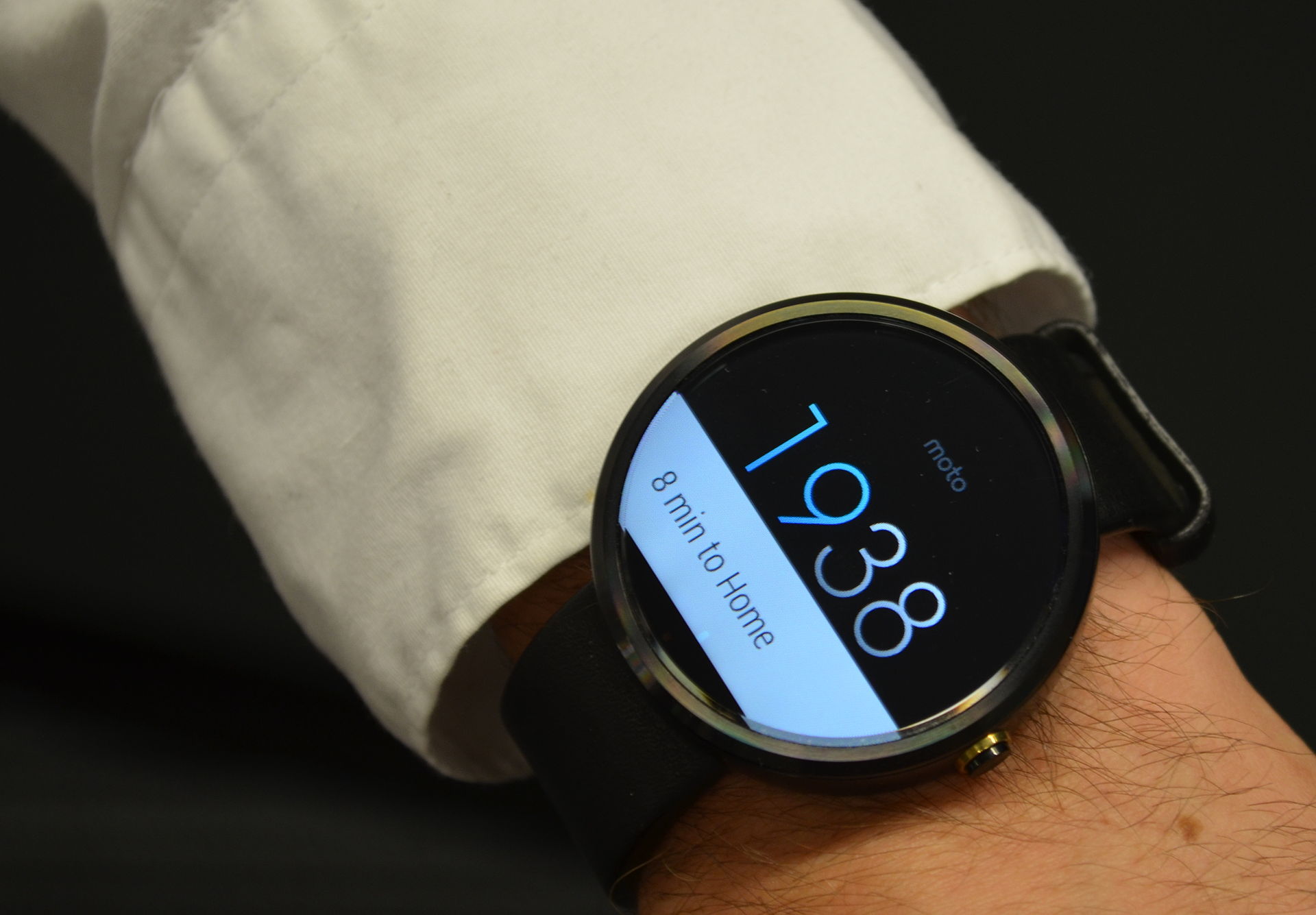
In the familiar Android smartphone, too, a lot happened. The most noticeable "outside" was the appearance of Material Design. And "inside" in the meantime, the Dalvik virtual machine was replaced with ART.
In addition, there was a new initiative to release smart phones with a “clean” OS - Android One. Unlike Google Play Edition, here it was not about flagships, but the opposite: the project leader Sundar Pichai was thinking about his native India and inexpensive devices. And this initiative turned out to be more successful than Google Play Edition, four years later, Android One-smartphones continue to appear regularly.
Vladimir Ivanov : Yohoho, Gradle gained popularity somewhere here! Hooray!
2015
The expansion to the new territories continued: Android Things (aka Brillo) was introduced to Google I / O 2015. Now, three years later, this project has not yet caused some great resonance. But it is worth remembering that only after the same three years, he finally reached the release: the version of Android Things 1.0 appeared this May. Let's see what will happen now, when it can be bolder to use.
Users in 2015 were much more noticeable things like Android Pay and fingerprint scanning. And although some manufacturers have already used scanners before, now Android itself has support for fingerprint authentication.
And the developers were more noticeable emergence of the Doze mode, when the device lying idle "deeply falling asleep" and reduces activity. This was the beginning of "tightening the screws": Google began to restrict applications in the background, to increase the battery life of devices. The goal, of course, is good, but over the past three years, actions in this direction have made many Android developers nervous.
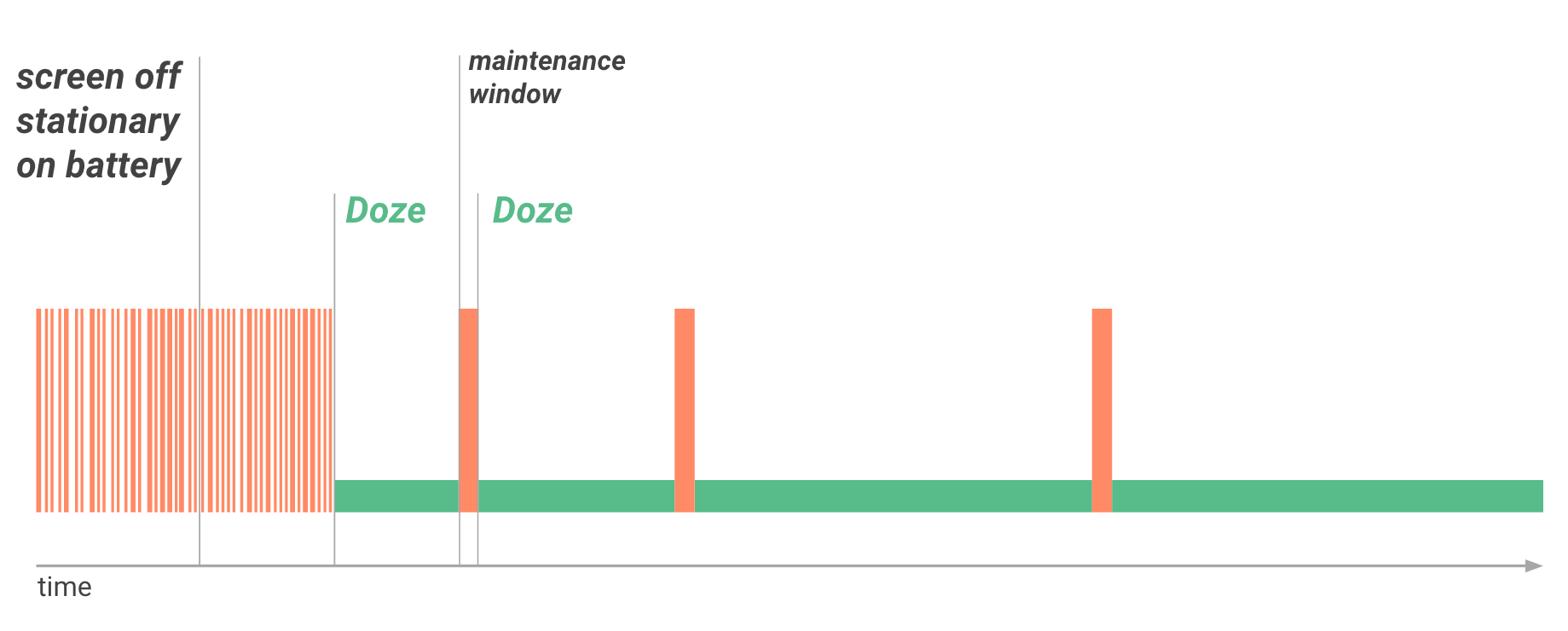
Back in 2015, the words “machine learning” sounded from the I / O scene, and in the following years, the Google abbreviation AI was more and more common in Google presentations. This has become the general line of the party: the phone should not just run applications, but understand how you use it, what you say, what you took on your photos, and what you generally need.
In the same year, the last two Nexus series devices were released: the Nexus 5X and the Nexus 6P. However, at that time it was not yet known that they would be the last.
Vladimir Ivanov : RxJava captures the world of android development. Damn that day ...
2016
And it is clear about the departure from the Nexus was a year later, when Google introduced the Pixel smartphone. If in the case of Nexus, each model appeared in partnership with some phone manufacturer, and on the back was the logo of this manufacturer, now Google has declared itself as a hardware company, and Pixel as a completely “own” phone. For the sake of justice, some participation of another company was, albeit not advertised: HTC and physically manufactured the device, and participated in its creation.
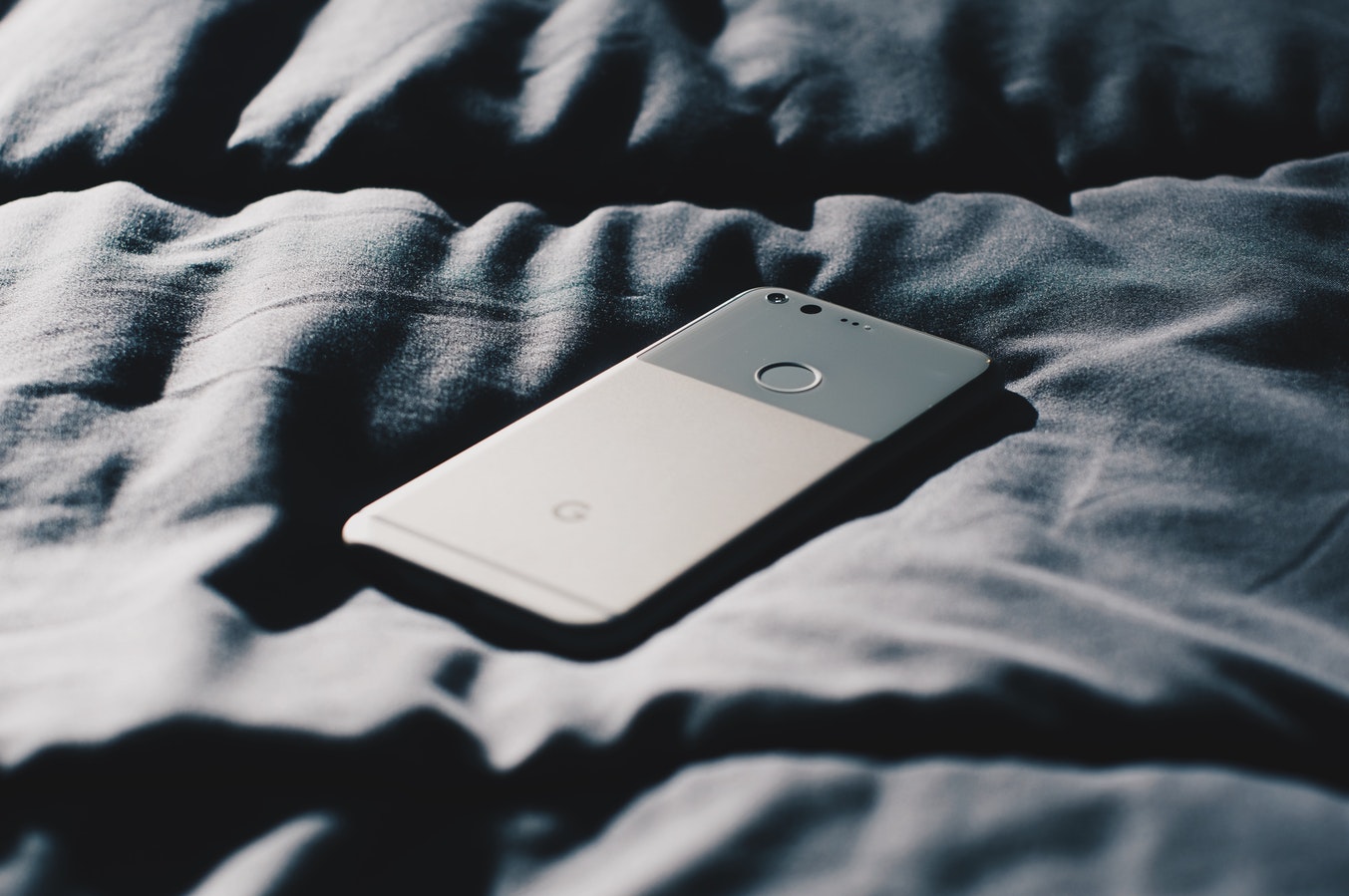
The day when Google did this, many waited cautiously: the company de facto became a competitor to the other manufacturers of android phones, that is, to their own partners. Moreover, she also used her position as a platform creator, promising Pixel customers exclusive nishtyaki (such as free storage of high-resolution images in Google Photos).
But the sky did not collapse, other manufacturers did not turn away from Android (it would be far from turning away), and their sales somehow did not suffer significantly. Here it is worth considering that Pixel does not even try to be the best-selling smartphone in the world (it is not even officially delivered to Russia). Instead, he tries to be " theAndroid phone "- a device that can be viewed as a reference" as Google sees the correct Android phone. " Not surprisingly, he, not being a record holder in sales, became at the same time the favorite of Android developers: with him you can be sure that you will see the new version of Android among the first.
In addition to Pixel, in 2016, the company tried to launch Project Tango. The idea was to release Android phones with additional cameras that help the phone understand its position in space and the objects around it. This was supposed to bring mobile augmented reality to an unprecedented level. In November, Lenovo started selling Phab 2 Pro, “the world's first phone with Tango support,” with great fanfare.
However, the first one was concurrently penultimate. It turned out that people are not eager to overpay for additional hardware in their smartphones. As a result, Google turned off the program and focused on its ARCore development for working with AR on ordinary smartphones.
And for developers in 2016, another event was more noticeable. By the time RxJava already occupied in the development of Android-the most important place, so in the fall, many have paid attention to the output RxJava 2. Directly on the same day it was released and the release RxAndroid 2 (the reader is waiting for so the words "Jake Wharton" - on here , take the same them soon).
2017
Among what was said on Google I / O 2017, the most annoying announcements were not aimed at users, but the information for Android developers: now Google has officially supported the Kotlin language. Many have already used it, but official approval dramatically accelerated the pace of the transition to Kotlin. Now, more than a year later, this language in Android development is no longer just a “new fashionable thing,” but a generally accepted standard.

It is worth noting that Google not only symbolically said “we do not object to Kotlin”, but does a lot from its side: from adding Kotlin examples to the documentation to the Android KTX project. The seriousness of the intentions well showed that Jake Wharton passed to Google for the sake of their realization: he was one of the first active supporters of Kotlin even before it became fashionable.
Vladimir Ivanov : Kotlin! Korutin! Coin! Hooray!
The main innovation of Android 8.0 Oreo, as well as support for Kotlin, is also not striking to ordinary users, but has the potential to help them. Project Treble is a modular architecture with which handset manufacturers should make it easier to update Android on them. Maybe even now with the updates will be better? So far, not enough time has passed to say with confidence - 85% of users do not yet have version 8.0, which makes changes.
And after Android One, there was an initiative designed for even more budget phones: Android Go. Together with the "normal" Android 8.0 released its special version, designed for phones that do not have more than one gigabyte of RAM. Google wants to get the “next billion” users - and those who haven't yet switched to smartphones in 2017 usually need cheap devices.
The Pixel series continued with the second flagship (they killed the mini-jack!), But more interesting in the case of Pixel is something else: Google decided not to depend on a third-party company when it released its phones, so he took and bought the half of HTC (the remaining half focused on HTC Vive and the Internet of Things). So the circle closed: in 2008, this company released the very first androidphone, when Android’s prospects were still unclear, but in the end it was so successful that it swallowed it up.
Closed and another big circle. In 2010, Nokia CEO Ansi Wyoki ridiculed the manufacturers of Android phones by comparingthem with "people who pee in their pants to keep warm." In subsequent years, the company, making a bet on Windows Phone, slowly sank with it, having lost its gigantic importance as a manufacturer of phones. In 2017, this ended with the fact that Windows Phone was officially closed, and the new Finnish company HMD Global began to produce smartphones under the Nokia brand - and Android was installed on them. In general, he laughs best who laughs last.
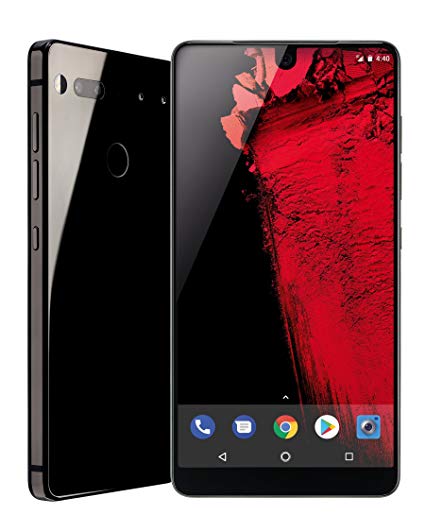
And the third is the completion of a great story. In 2017, the new company Andy Rubin released its first product, Essential Phone. It became the first “cutout” phone in the world at the top of the screen, ahead of the iPhone X, and there were a number of other features like a special camera for black and white photography. But, unlike the iPhone X, this phone was not in demand. As a result, according to Bloomberg , the company simply refused to develop the next smartphone, and the ambitious venture ended in defeat.
If you compare these three stories, it turns out that by the 10th anniversary of Android, I devoured everyone, including its creator.
Nowadays
What's next? Android is unlikely to change as rapidly as at the beginning of the journey, and this is expected. But this does not mean that now all the news will be reduced to updating the processors. For the next decade, Google still has large unsolved problems.
One of them is the issue with updates. Formally, Android 9.0 Pie has been released for more than a month, but after a month or more, the proportion of updated devices is so tiny that it is not displayed at all on the official deshboard .
The other is the “next billion”. Of course, more than two billion active users are a lot. But it is still far less than the people on the planet. And Google is clearly thinking about how this can be changed.
The third is Android outside of smartphones. The plans with watches, TVs and cars did not fail, but they were not yet named a great success. Producers of smartphones once abandoned attempts to make their own OS in favor of someone else's decision - is it possible to achieve the same with televisions? And the ability to run Android applications on Chromebooks will lead to something?
There is also a common ambitious task: “clever” phone. Google wants to help the user before he can formulate what he needs. How close will the current development of machine learning be to this? Hardly anyone, including Google, knows the answer, but in this direction they will clearly continue to make efforts.
With all this, Google is simultaneously developing a new OS Fuchsia, which hypothetically could even replace Android. As well as Flutter, which allows you to write applications immediately for Fuchsia, and for Android, and for iOS. But it’s too early to talk about the prospects for all this.

Therefore, we end up with a much more modest and short-term forecast: judging by the available information, Pixel 3 will be presented on October 9th. And this is the first phone, in the case of which Google never turned to third-party manufacturers for help, and therefore it is especially interesting to know what happened. The appearance is already known for leaks , but in the case of Pixel this was never the main thing: first of all, Google is still a software company.
Surely in the post we missed something significant, and it was just interesting to learn about your experience - so a nostalgia parade is welcomed in the comments. What was your first android phone? What did you lack most in Android then? Is there something that used to be, but now is not enough?
Minute advertising. If you not only use mobile applications, but also develop them yourself, pay attention: Mobius will be held in Moscow on December 8-9, and there will be a lot of interesting things there. And if you yourself are ready to share something useful - the receipt of applications for reports is open until October 1.
Only registered users can participate in the survey. Sign in , please.
